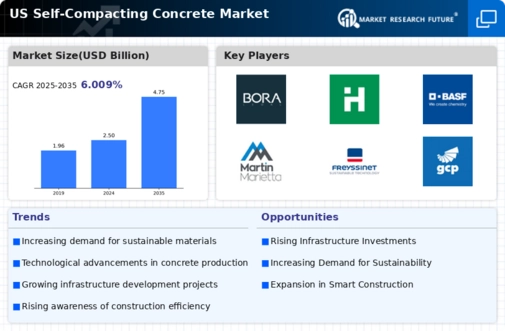Government Regulations and Standards
Government regulations and standards play a crucial role in shaping the self compacting-concrete market. In the US, stringent building codes and environmental regulations are increasingly influencing material selection in construction projects. These regulations often mandate the use of sustainable and high-quality materials, which aligns with the properties of self compacting concrete. As a result, the self compacting-concrete market is likely to benefit from these regulatory frameworks, as they encourage the adoption of advanced materials that enhance structural integrity and reduce environmental impact. The market is expected to see a rise in demand as compliance with these regulations becomes more critical for construction firms.
Growing Awareness of Construction Efficiency
There is a growing awareness of the importance of construction efficiency within the self compacting-concrete market. As project timelines become increasingly tight, contractors are seeking materials that can streamline operations and reduce delays. Self compacting concrete offers significant advantages in this regard, as it eliminates the need for vibration during placement, thereby accelerating the construction process. The self compacting-concrete market is likely to see heightened interest from builders looking to optimize their workflows and minimize labor costs. This trend is expected to contribute to a steady increase in market share, as more construction professionals recognize the benefits of using self compacting concrete.
Rising Demand for High-Performance Materials
The self compacting-concrete market is experiencing a notable increase in demand for high-performance materials. This trend is driven by the construction industry's need for durable and efficient solutions that can withstand various environmental conditions. As infrastructure projects become more complex, the requirement for materials that offer superior strength and workability is paramount. In 2025, the market is projected to grow at a CAGR of approximately 8.5%, reflecting the construction sector's shift towards innovative materials. The self compacting-concrete market is well-positioned to meet these demands, as it provides enhanced flowability and reduces labor costs, making it an attractive option for contractors and builders alike.
Increased Investment in Infrastructure Projects
The self compacting-concrete market is poised for growth due to increased investment in infrastructure projects across the US. Federal and state governments are allocating substantial budgets for the development and maintenance of roads, bridges, and public facilities. This influx of funding is expected to drive demand for efficient construction materials that can expedite project timelines and improve overall quality. The self compacting-concrete market stands to gain from this trend, as its properties allow for faster placement and reduced labor costs. In 2025, infrastructure spending is projected to reach over $1 trillion, further solidifying the market's potential for expansion.
Technological Innovations in Concrete Production
Technological innovations in concrete production are significantly impacting the self compacting-concrete market. Advances in mixing techniques and material formulations are enhancing the performance characteristics of self compacting concrete, making it more appealing to the construction industry. Innovations such as the use of superplasticizers and advanced admixtures are improving workability and durability, which are critical factors for modern construction projects. The self compacting-concrete market is likely to benefit from these technological advancements, as they enable the production of high-quality concrete that meets the evolving demands of builders and engineers. As these technologies continue to develop, the market is expected to expand further.






















Leave a Comment